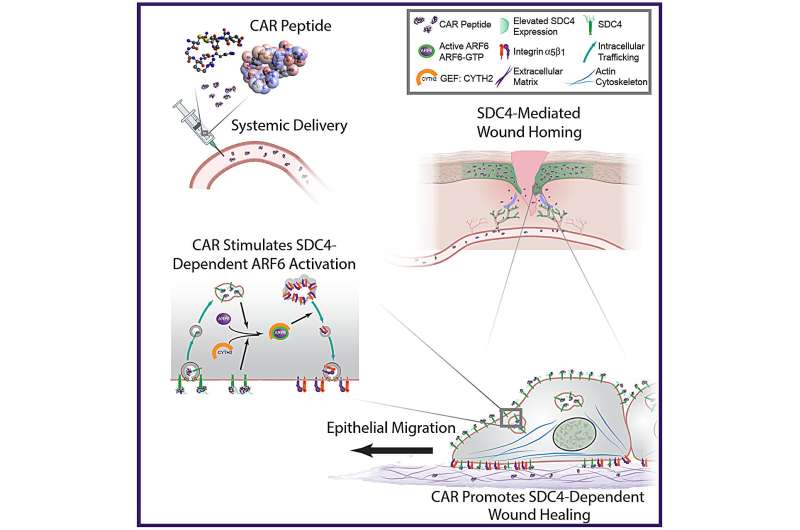This article has been reviewed according to Science X's editorial process and policies. Editors have highlighted the following attributes while ensuring the content's credibility:
fact-checked
trusted source
proofread
Wound-homing molecule found to accelerate tissue repair

One of the key goals of medical science is to speed up the healing of tissue injuries in a way that doesn't enable the forming of less functional scar tissue in the affected areas. Professor Tero Järvinen at Tampere University in Finland is leading research that's seeking solutions to achieve this goal.
In an earlier study, Järvinen discovered a so-called homing peptide, a small piece of protein that specifically seeks tissue damage via the bloodstream. The homing peptide was named the CAR peptide after its amino acid composition. It was screened out of more than a billion peptides using the screening technology of in vivo phage display. The peptide was used to transport a scar-reducing drug to the wounds via systemic administration.
Recently, the research group showed that the CAR transport peptide is itself a therapeutic drug. CAR activates a natural healing pathway crucial for tissue regeneration and accelerates wound healing without the need to attach to any kind of drug.
Their recent study, published in Nature Communications, confirmed that the CAR peptide activates the tissue regeneration mechanism that is critical for wound healing by entering the wound through the bloodstream. In the wound, the peptide binds to syndecan-4, a cell membrane receptor. This binding activates the intracellular cytohesin-2 factor, which in turn activates the Arf6 GTPase that triggers cell migration, i.e., the migration of regenerating cells across the damaged area in the wound.
By this molecular mechanism, the skin wounds in mice receiving the CAR peptide healed significantly faster than without the therapy. The ensuing scars were also smaller than those without treatment. As this syndecan-4-dependent cell migration mechanism is crucial for the healing of multiple injuries, such as skeletal muscle ruptures and bone fractures, the CAR peptide has multiple clinically relevant indications not just for traumatology but also for surgery and sports medicine.
"Syndecan-4-dependent tissue regeneration is a key factor in the healing of several other tissue injuries beyond skin wounds, including muscle ruptures and bone fractures. The CAR peptide we found, which activates this natural healing mechanism, opens completely new possibilities for treating traumas and injuries not only in traumatology but also in surgery and sports injuries."
"Because the drug molecule actively seeks tissue damage through the bloodstream, the treated injury can be in any part of the body and can be targeted by the CAR peptide therapy," Järvinen explains.
More information: Horacio Maldonado et al, Systemically administered wound-homing peptide accelerates wound healing by modulating syndecan-4 function, Nature Communications (2023). DOI: 10.1038/s41467-023-43848-1



















